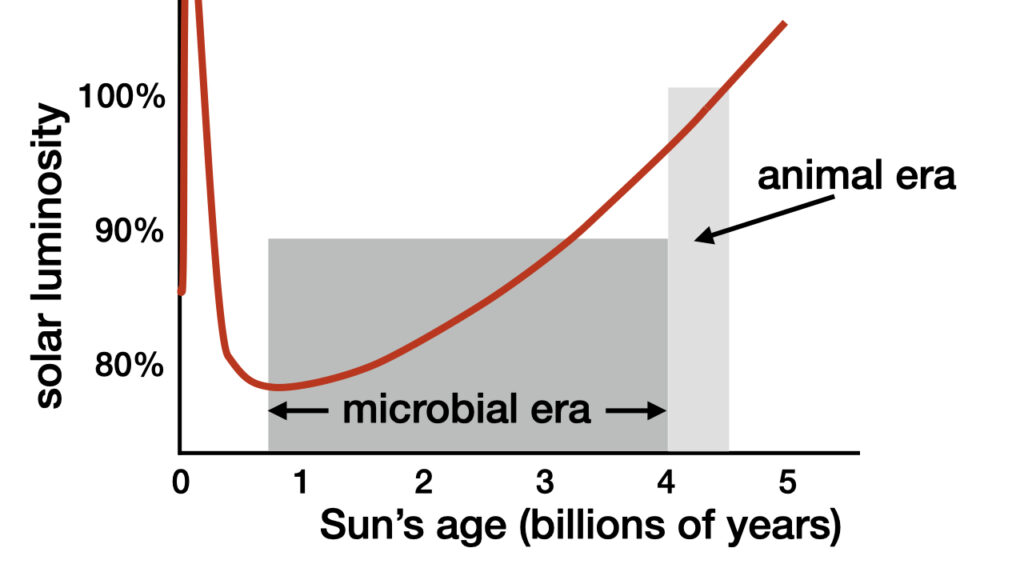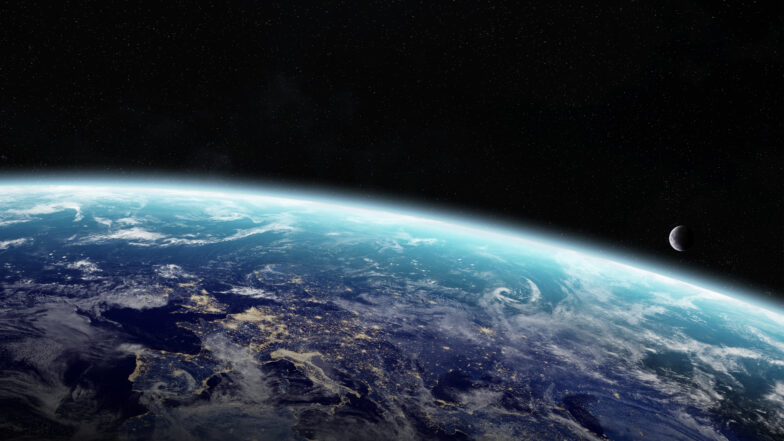What Darwin Didn’t Know about the Sun
Charles Darwin is widely acknowledged as “one of the most influential figures in human history.”1 The New Scientist credits Darwin’s seminal books, On the Origin of Species2 and The Descent of Man,3 as doing the most “to knock man off his pedestal.”4
Darwin’s proposition that all life on Earth is descended by strictly naturalistic mechanisms from a common ancestor—the first microbe—fundamentally rested on the assumption that the Sun’s energy output has not changed throughout the entire history of life on Earth. In Darwin’s day, scientists presumed that the Sun’s radiation output was constant. Therefore, the Sun did not factor into Darwin’s hypothesis for the origin of species. He is not alone. Evolutionary biologists, geneticists, and paleontologists today likewise do not factor possible changes in the Sun into their explanations for life’s history.
During Darwin’s lifetime, the only known source for the Sun’s radiation output was gravitational collapse. Physicists, notably Lord Kelvin, calculated that the Sun’s energy output must have remained unchanged throughout the existence of life.
It is now indisputably established that 99% of the Sun’s energy output arises from the nuclear fusion of hydrogen into helium and the remaining 1% from the nuclear fusion of helium into carbon, nitrogen, and oxygen.5 Helium, carbon, nitrogen, and oxygen are all much denser than hydrogen. Therefore, ongoing nuclear fusion causes the density in the Sun’s core where nuclear fusion occurs to increase continuously. This increasing solar core density results in the Sun’s nuclear furnace burning ever more efficiently. Today, the Sun is 19–24% more luminous (brighter) than it was at the time of life’s origin 3.8 billion years ago (see figure).

Diagram credit: Hugh Ross
Normally, a 2% change in solar luminosity would wipe out all life, either through a runaway freezing or a runaway evaporation of all surface water. A 1% change would mean the end of advanced plants and animals. What prevented such a catastrophe from occurring was a perfectly measured and timed drawdown of Earth’s greenhouse gases, combined with a perfectly measured and timed alteration of Earth’s albedo (reflectivity). As the Sun kept getting brighter and brighter, the quantity of atmospheric greenhouse gases decreased and Earth’s albedo altered so that the planet’s temperature remained optimal for life.
The drawdown of greenhouse gases plays, by far, the biggest role in compensating for the Sun’s increasing luminosity. That drawdown occurs through two processes: the silicate-carbonate cycle and the burial of organic carbon. The silicate-carbonate cycle is where rain and dew, acting as a catalyst, falls on exposed silicates (the continents are predominantly silicate rock), generating a chemical reaction of converting silicates and carbon dioxide (a powerful greenhouse gas) from the atmosphere into carbonates and sand.6
Different life-forms regulate how much silicate rock gets exposed to liquid water, how much dew forms, and how much rain falls from clouds. For example, shrubs and trees possess root systems capable of penetrating the upper 6 meters (20 feet) of bedrock,7 thereby greatly expanding the silicate surface area that is exposed to liquid water. These same shrubs and trees are able to access and use water stored in bedrock, converting most of this water into transpiration (exhalation of water vapor to the atmosphere through their stomata). This transpiration increases rates of precipitation. The increased precipitation accelerates the silicate-carbonate cycle, which draws more carbon dioxide from the atmosphere.
Microbes, plants, and animals all take carbon dioxide from the atmosphere, either directly or indirectly, to manufacture organic carbon compounds. The burial of the bodies of these organisms by floods, landslides, volcanic eruptions, or other tectonic events prevents the decay of the bodies and the release of carbon dioxide to the atmosphere.
Ensuring that the just-right kinds, diversity, and abundance of life exist at just-right times and places guarantees that greenhouse gases are removed from the atmosphere at just-right rates to compensate for the Sun’s increasing luminosity. Furthermore, life is so abundant and ubiquitous that it substantially affects Earth’s albedo, both altering the cloud cover and the reflectivity of Earth’s surface. Thus, organisms compensate for the Sun’s increasing luminosity in four different ways: (1) by regulating the silicate-carbonate cycle, (2) by altering the organic carbon burial rate, (3) by changing the atmospheric chemistry and cloud cover, and (4) by changing Earth’s reflectivity.
It is not just the Sun’s luminosity that changes over time. The kinds of radiation emitted by the Sun also change in dramatic ways. Similarly, solar flaring activity and luminosity variability change, too. These alterations affect which kinds of life can thrive on Earth at which times. Such changes pose a challenge to ensuring that just-right life is present to compensate for the Sun’s increasing luminosity.
Unless all four of life’s compensating factors are at just-right levels at all times throughout the past 3.8 billion years, then life no longer thrives and most likely becomes extinct. The naturalistic processes affecting change in Earth’s life—natural selection, mutations, gene exchange, and epigenetics—possess no inherent knowledge of future solar physics.
Only a Mind who knows the future physics of the Sun, Earth, and Moon will know which life must be present on Earth at which times. For life to persist for 3.8 billion years on Earth, Someone who knows and understands the present and future physics of the Sun, Earth, and Moon must periodically remove certain life-forms that are no longer able to compensate for the changes in the Sun and replace that life with new just-right life-forms at just-right times in just-right amounts, diversity, and locations.
Given the pace at which the Sun’s luminosity is increasing, mass extinction events quickly followed by mass speciation events must occur at a rate of about once every 30–35 million years. The fossil record bears witness to this rate of extinction and speciation.8 In each mass extinction event just-right organisms are removed at the just-right time and in each mass speciation event just-right life appears at the just-right time.
Endnotes
- Editors, “Special Feature: Darwin 200,” New Scientist, February 11, 2009, https://www.newscientist.com/round-up/darwin-200/.
- Charles Darwin, On the Origin of Species by Means of Natural Selection (London, John Murray, 1859).
- Charles Darwin, The Descent of Man and Selection in Relation to Sex (London, John Murray, 1871).
- “Special Feature: Darwin 200.”
- Hugh Ross, “Solar Design: Resolving the Solar Abundance Problem,” Today’s New Reason to Believe (blog), Reasons to Believe, January 11, 2021.
- Hugh Ross, Improbable Planet (Grand Rapids, MI: Baker, 2016), 160–162.
- Erica L. McCormick et al., “Widespread Woody Plant Use of Water Stored in Bedrock,” Nature 597, no. 7875 (September 9, 2021): 225–229, doi:10.1038/s41586-021-03761-3.
- Adrian L. Melott and Richard K. Bambach, “Do Periodicities in Extinction—With Possible Astronomical Connections—Survive a Revision of the Geological Timescale?” Astrophysical Journal 773, no. 1 (August 2013): id. 6, doi:10.1088/0004-637X/773/1/6.






